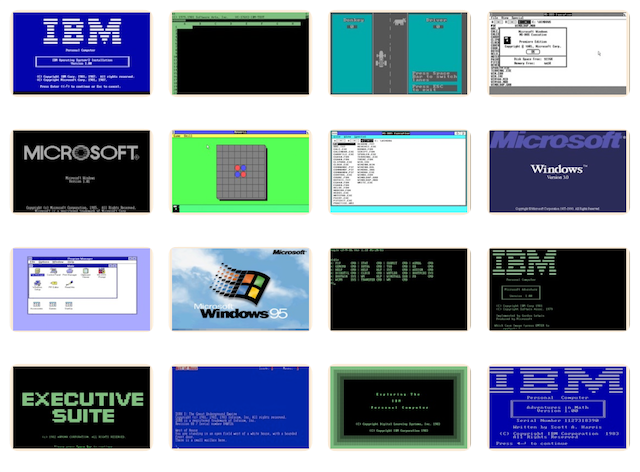PCjs Machines
Home of the original IBM PC emulator for browsers.

PCjs Archive Utility
This directory contains dx.js, a stand-alone JavaScript command-line utility I created for displaying and extracting the contents of assorted archives and disk images. It is built upon several other stand-alone JavaScript classes, the key ones being:
- dzip.js (to read ZIP and ARC archive files)
- disk.js (to read IMG and JSON-encoded disk images used by PCjs)
- iso.js (to read ISO, MDF, and other ISO 9660 disc images)
dzip.js uses the LegacyARC and LegacyZIP classes in legacy.js, which add support for compression methods older than deflate, which is the only compression method that modern zlib-based utilities support.
To simplify container handling for both command-line and browser clients, the dxc.js wrapper class provides functions that deal with the appropriate container class, based on the container’s extension (eg, .zip, .iso, etc):
- async open()
- async readDirectory()
- async readFile()
- filterEntry()
- formatEntry()
- formatHeading()
- async close()
And there’s a test page to exercise dxc.js container processing in your web browser.
Finally, there are some Python scripts here to assist with uploading files to the Internet Archive. They are designed for use with the --upload option in dx.js.
Basic Usage
Here are the prerequisites for command-line operation:
- Install Node and NPM
- Clone the pcjs repository (eg,
git clone https://github.com/jeffpar/pcjs.git) - CD into
pcjsand runnpm install - From the
pcjsdirectory, CD to thetools/dxdirectory
The format of a dx.js command (as --help will also tell you) is:
[node] dx.js [options] [archive(s)]
Here is the complete help text:
dx.js 1.0
Copyright © 2012-2025 Jeff Parsons <Jeff@pcjs.org>
Arguments: dx.js -h
Usage:
dx.js [option(s)] [item(s)]
Processes ZIP, ARC, IMG, ISO, MDF and other container items
Options:
--batch [file] process items listed in file
--banner print archive comments (banners) [-b]
--compat use CD-ROM 8.3 filenames only [-c]
--csv [file] write list of item contents to CSV file
--dest [dir] extract files into destination directory [-d]
--dir print directory of item contents
--dump [spec] dump contents of matching files
--extract extract files (implied by --dest) [-e,-x]
--files [spec] filter on matching files (eg, "*.txt")
--filter [...] filter on criteria (see --filter list) [-f]
--in [encoding] set input encoding (default is cp437)
--list print list of item contents [-l]
--nodir skip archive directory (scan for files) [-n]
--out [encoding] set output encoding (default is --in)
--overwrite overwrite existing files on extract [-o]
--password [...] decrypt garbled entries using password [-g,-s]
--path [spec] process matching items (eg, "**/*.zip")
--pause pause after each item until a key is pressed [-p]
--recurse process items within items [-r]
--test test contents of all items [-t]
--type [spec] type contents of matching files
--upload generate an upload script for the Internet Archive
--verbose display additional information [-v]
--help display this help message [-h]
Uploading Files to the Internet Archive
In 2018 and 2019, I digitized lots of CD-ROMs, including hundreds of Microsoft TechNet CD-ROMs, with the intention of eventually uploading them to the Internet Archive. However, I was unfamiliar with the process and I wanted to avoid uploading images that already existed in the archive, so it wasn’t until 2025, with the help of this utility, that I finally began looking for gaps that I could help fill in the Internet Archive’s collection.
I started by using this utility’s --csv option to produce a spreadsheet of all my own TechNet CDs, then with the help of the Internet Archive’s Python Package and a search.py script, I produced a list of TechNet CDs already in the Archive. I fed that list into dx.js using the --batch option and appended the results to the same spreadsheet using --csv again.
Then I added an --upload option to sort the CDs in my spreadsheet by volume name, number of entries on the volume, etc, filter out all the duplicates, and then generate a bash script to upload the remaining items.
Here’s a stripped-down example of what --upload produces:
# uploading MSTN-CD177-ARMEFPP_EN.iso
cp "/Software/Discs/Microsoft/TechNet/MSTN-CD177-ARMEFPP_EN.iso" ARMEFPP_EN.iso
cp "/Software/Discs/Microsoft/TechNet/MSTN-CD177-ARMEFPP_EN.png" ARMEFPP_EN.png
node dx.js ARMEFPP_EN.iso --dir --truncate > desc.txt
python upload.py ms-technet-armefpp_en "Microsoft TechNet ARMEFPP_EN Disc (March 2005)" 2005-03-25 desc.txt ARMEFPP_EN.iso ARMEFPP_EN.png
rm desc.txt ARMEFPP_EN.iso ARMEFPP_EN.png
The upload script modifies my original image filename to match the disc’s volume name (since no one else cares about my personal naming scheme), includes any matching photo image, and then passes that information to upload.py to create a new item in the Internet Archive.
Later, I added an --update option to generate another bash script that calls update.py to update selected metadata (eg, title and description). After generating the initial script, I modified it by hand, changing all the title dates to match those printed on the faces of the CDs. For the initial dates, I had relied on the Creation Date stored in the CD-ROM volume descriptor. Unfortunately, Creation Date usually pre-dated whatever Microsoft ultimately printed on the face of the CD-ROM, often by one month or more.
The upload of TechNet CDs is now complete, and you can browse the results here.